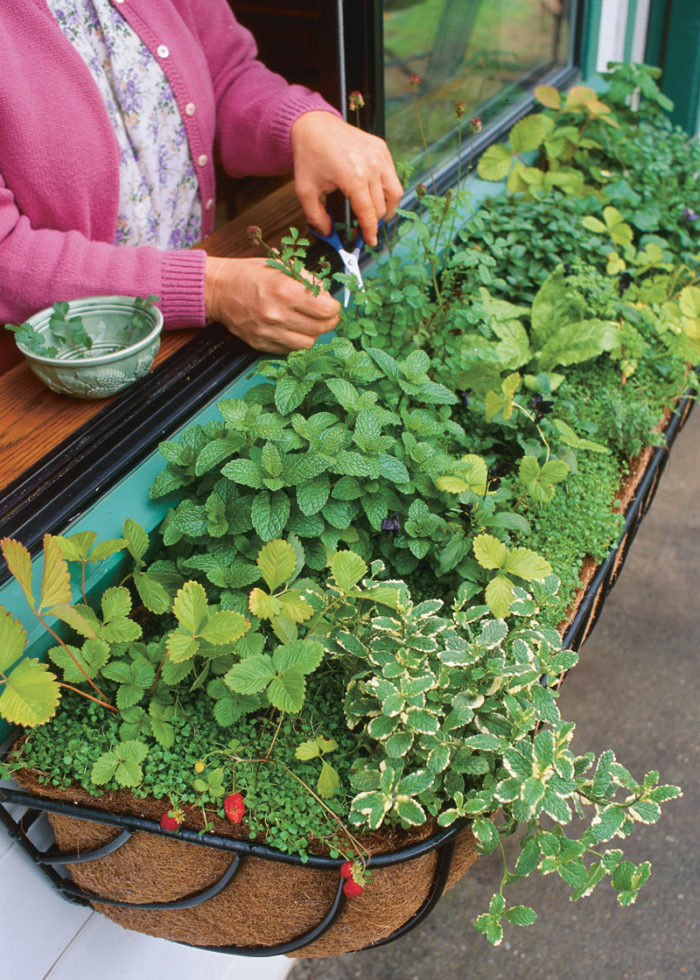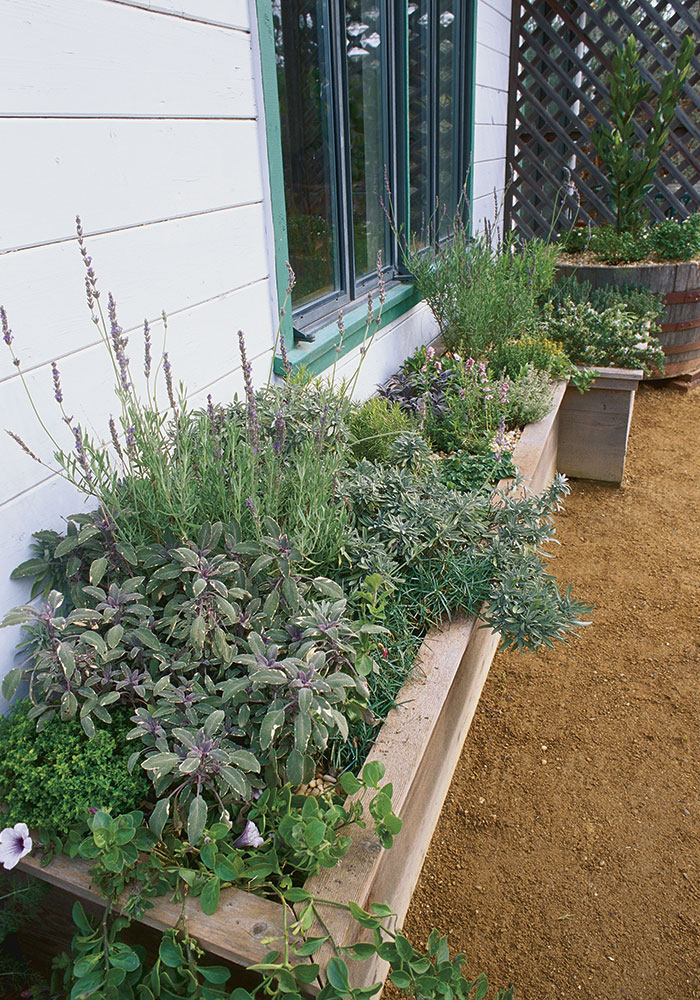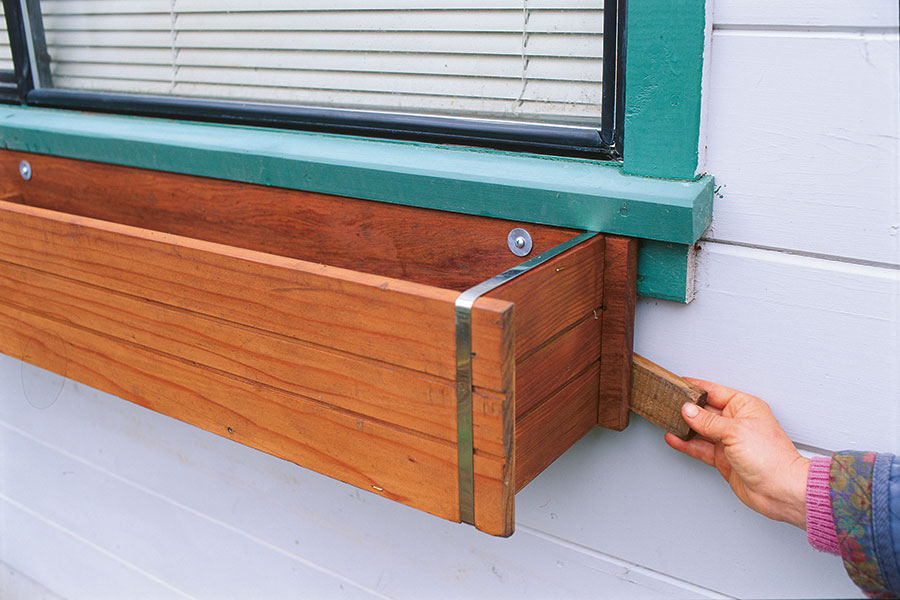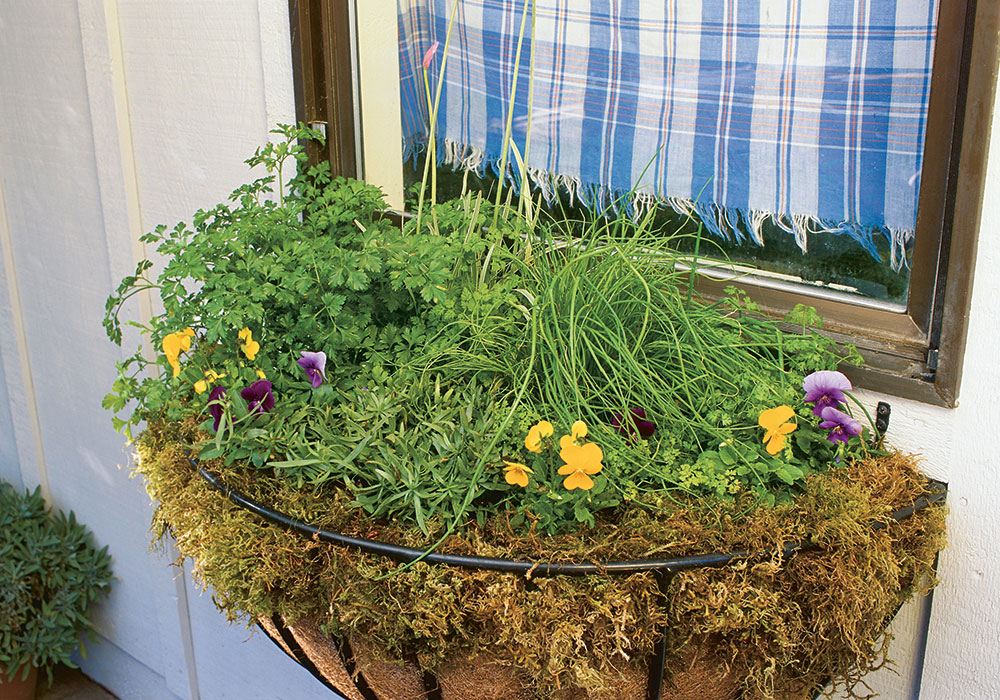Growing Herbs in Window Boxes
Short on garden space? Grow these tasty plants in a spot right outside your kitchen

The sun set hours ago, and a steady, cold rain is falling. But there’s no need to put on rain gear and find the flashlight for a trip to the herb garden. I simply reach out the kitchen window for a last-minute addition to our dinner salad—a rain-washed sprig of cucumber-flavored salad burnet. Ever since I planted my first culinary herbs and discovered I wanted them just outside the door, I dreamed of window boxes spilling over with fragrant herbs. Now I have several boxes in different themes. Near at hand, the herbs get used a lot in my daily cooking.
Window boxes are perfect for culinary herbs
Many of them grow well in confined spaces, and window boxes provide the good drainage essential to most herbs. In addition, the Mediterranean ones will like staying drier under the eaves in areas of high summer rainfall. Eaves also give some protection from the cold, and being against the house wall further moderates temperature extremes.
Even the gardener with very little space can usually find room for a window box. If you have room for only a tiny box, simply select herbs from among the smallest varieties—miniature thyme, ‘Blue Boy’ rosemary, ‘Minette’ basil, dwarf moss-curled parsley—and avoid those that can easily take over a small space, such as mints, chamomile, and standard varieties of oregano, rosemary, and lavender.
With several boxes in different exposures, you can grow a variety of herbs. Hot, sunny sites are ideal for herbs from Mediterranean climates. A truly shady location will accommodate only a few varieties, but a window box in dappled light is ideal for shade-tolerant herbs. An eastern exposure is fine for most varieties.
Design your box to fit your style
It’s fun to come up with themes for my herb-garden boxes. Some of my favorites are included here, but play around with combinations that suit your own cooking style. As I become interested in different cuisines and periodically renew the plantings, I redesign my boxes to suit my current culinary interests.
My Provençal garden is the biggest. It’s not a window box in the traditional sense; rather, the plants are set into a large box that rests directly on the ground under a low-set window. Mediterranean herbs grow well here in Northern California, and I use them often in the kitchen. On a warm southern exposure, I grow my version of the herbes de Provence mix: thyme, winter savory, rosemary, sage, lavender, and sweet marjoram.

Nearby, I have some bronze fennel in a large pot, and a half-barrel holds a bay laurel. During the warmer months, I grow summer savory in a corner of the box and tuck in a few annual flowers. In addition, I have added to my Provençal pot a number of the flavored thymes I enjoy cooking with—lemon, lime, oregano thyme, and ‘Orange Balsam’. This last, with its resinous orange-peel flavor, is particularly well suited to Provençal cooking.
Italian herbs are in a box on an east-facing window. Although oregano, sweet marjoram, rosemary, and sage are happiest in a southern exposure, they still grow well with only a half-day of sun, and the basils, leaf celery, and parsley appreciate the afternoon shade. The various colored sages—golden, purple, and tricolor—are wonderful for creating some contrast. A fennel plant or a bay laurel in a large pot nearby is appropriate to this plant grouping.

My shady window box is a favorite, with its refreshing minty aroma and edging of jewel-like alpine strawberries. Try chervil, mints, parsley, leaf celery, violets and violas, alpine strawberries, sorrel, lemon balm, cilantro, and sweet woodruff. In full shade, only a handful of herbs will do well. Use mints, violets, sweet woodruff, and chervil for an attractive planting. Experiment a little until you know exactly how far you can push it; you may be pleasantly surprised.
Fines herbes—chives, tarragon, chervil, parsley—is a classic of French cuisine. I grow all four in one large basket on an east wall, but they could as well be in a window box. The chervil will grow only in cool weather, so I sow seeds every few weeks for a longer season. During warmer weather, I use a little more tarragon in my cooking and leave out chervil. In summer, a couple of nasturtiums trailing down the edge give a lovely effect. Fines herbes are delicious in omelets, sprinkled on a creamy cheese, or in a spring salad of butter lettuce.

I like to plant a basket of the various basils near my kitchen. There’s not enough for large batches of pesto, but I use it often to add a bit of flavor to a dish. There are many basils that will work. My last basket contained Thai, ‘Mammoth’, ‘Genova’, ‘Red Rubin’, and ‘Cinnamon’. Others to try include lemon basil, dwarf bush basil, and ‘Purple Ruffles’. ‘Cinnamon’ basil blossoms are delightful in fruit salads; lemon basil has an affinity for fish, and Thai basil is a natural in Asian cuisines.
Right plant, right box
Dwarf varieties of many herbs are available and will fit right into a window box environment. Among them are miniature thymes, compact oregano, dwarf sage, and small forms of parsley, basil, chives, and dill. Dwarf ‘Blue Boy’ rosemary has a better flavor and is more compact than prostrate rosemary. Dwarf sage has narrow, silver-colored leaves and impressive spikes of purple flowers in spring and summer. Dwarf forms of oregano don’t share the same strong flavor of their Greek and Italian brothers, but they still taste of oregano and are much smaller.
Naturally compact herbs also work well in all but the smallest window boxes. Tarragon, chervil, sweet marjoram, creeping winter savory, many of the oreganos, sweet woodruff, and chives are but a few possibilities. Most of the thymes work well in confined situations. I like to use silver and lemon variegated thymes for the contrast they provide. Among the rosemaries and lavenders, look for varieties that stay under 2 feet tall.

Choose sturdy, well-built boxes, as wide and deep as possible. Be sure to install boxes securely, as they’ll be heavy when full, even with a lightweight potting mix. We install boxes to leave a gap between the back of the box and the siding to allow for air circulation; this is especially important if your house has wood siding.
Potting mix should be lightweight, drain well, and yet hold moisture. I use a commercial mix to which I add compost and fertilizer. If you’re concerned about weight, mix in some perlite. Fill the box to the top, and water it well to settle the soil before planting. The final soil level should be 1 inch to 2 inch below the rim of the planter.
Arrange plants in an attractive group before planting, as it’s easier to work out a pleasing combination while they’re still in their pots. I try to place thirstier plants toward the back and middle of the boxes, where the soil stays moist the longest. Most contrast is provided by foliage, so keep in mind color, texture, and form when working. I harvest regularly, so I plant herbs close together for a full look.
I enjoy some color in my boxes, so I fill in with annual flowers such as gem marigolds, violas, and nasturtiums. These are all edible flowers, although low-growing, nonedible annuals such as alyssum, creeping daisies, or lobelia will also work well. Small bulbs such as species daffodils, crocus, and grape hyacinth are another way to add seasonal color. I sometimes use small-scale perennials (violets and alpine strawberries are especially suitable) in my herb window-box gardens.

Remember, if you have wide eaves, no rainfall will reach your boxes, and regular watering will be necessary. A small drip system on a timer works well. Herbs in boxes also need regular fertilizing, even those from the Mediterranean. I use a complete, organic, slow-release, granular fertilizer. If you harvest frequently, plants will stay compact.
Periodically renew the window boxes. Early spring or fall is a good time to do this. Discard any spent plants, and top prune and root prune (especially spreading herbs like mint) to keep the perennials compact. Replace as much spent soil as practical with fresh soil and fertilizer. Replant, add any new plants, and you have a rejuvenated beauty of a box just outside your kitchen window. If you live where the ground freezes, dig up any sensitive plants and winter them in a sunny, enclosed space where the temperature remains above 40°F.
From Kitchen Gardener #14
Fine Gardening Recommended Products

A.M. Leonard Deluxe Soil Knife & Leather Sheath Combo
Fine Gardening receives a commission for items purchased through links on this site, including Amazon Associates and other affiliate advertising programs.

The New Organic Grower, 3rd Edition: A Master's Manual of Tools and Techniques for the Home and Market Gardener, 30th Anniversary Edition
Fine Gardening receives a commission for items purchased through links on this site, including Amazon Associates and other affiliate advertising programs.

Attracting Beneficial Bugs to Your Garden, Revised and Updated Second Edition: A Natural Approach to Pest Control
Fine Gardening receives a commission for items purchased through links on this site, including Amazon Associates and other affiliate advertising programs.





Comments
Log in or create an account to post a comment.
Sign up Log in